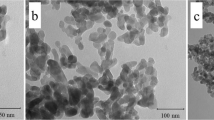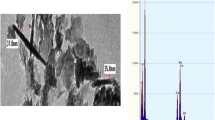Abstract
Due to their small size, zinc oxide (ZnO) nanoparticles (NPs) are readily absorbed and easily cross biological barriers, which make them promising candidates as diet additives. However, some studies have reported that ZnO NPs cause toxicity; therefore, their safety and potency as diet additives for farm animals should be established. This study was the first to fully evaluate the effects of ZnO NPs on the homeostasis of eight elements in seven organs/tissues. The regulation of element homeostasis was found to be organ specific with no influence on oxidation status, anti-oxidation capability, or organ damage. ZnO NPs may specifically regulate the homeostasis of mineral elements and affect the following correlations: (1) between the element content in each organ and the concentration of Zn used in ZnSO4 or ZnO NP treatments; (2) between ZnO NP and ZnSO4 treatments for the same element in each organ; and (3) between elements (in each organ in ZnSO4 or ZnO NP treatments) in layers’ organs/tissues. The use of ZnO NPs as diet additives for animals should be implemented cautiously because, among other uncertainties, they may affect mineral element content.





Similar content being viewed by others
References
Brandão-Neto J, Stefan V, Mendonça BB, Bloise W, Castro AVB (1995) The essential role of zinc in growth. Nutr Res 15:335–358
Powell SR (2000) The antioxidant properties of zinc. J Nutr 130:1447S–1454S
Zhao CY, Tan SX, Xiao XY, Qiu XS, Pan JQ, Tang ZX (2014) Effects of dietary zinc oxide nanoparticles on growth performance and antioxidative status in broilers. Biol Trace Elem Res 160:361–367
Bondarenko O, Juganson K, Ivask A, Kasemets K, Mortimer M, Kahru A (2013) Toxicity of Ag, CuO and ZnO nanoparticles to selected environmentally relevant test organisms and mammalian cells in vitro: a critical review. Arch Toxicol 87(7):1181–1200
Miller R, Lenihan H, Muller E, Tseng N, Hanna S, Keller A (2010) Impacts of metal oxide nanoparticles on marine phytoplankton. Environ Sci Technol 44:7329–7334
Tian L, Jiang J, Zhu F, Ren H, Li W (2010) Effects of nano-zinc oxide on the immune performance and zinc concentration in tissues of broiler. Journal of Qingdao Agricultural University (Natural Science) 27(4):315–318 In Chinese
Huang K, Liu Y, Zhu F, Ning X, Zhu L (2013) Biological function of nanometer zinc oxide adhibition in swine production. Feed review 43(3):43–45 In Chinese
Talebi AR, Khorsandi L, Moridian M (2013) The effect of zinc oxide nanoparticles on mouse spermatogenesis. J Assist Reprod Genet 30:1203–1209
Jo E, Seo JG, Kwon T, Lee M, Lee BC, Eom I, Kim P, Choi K (2013) Exposure to zinc oxide nanoparticles affects reproductive development and biodistribution in offspring rats. J Toxicol Sci 38:525–530
Brun NR, Lenz M, Wehrli B, Fent K (2014) Comparative effects of zinc oxide nanoparticles and dissolved zinc on zebrafish embryos and eleuthero-embryos: importance of zinc ions. Sci Total Environ 476-477:657–666
Lopes S, Ribeiro F, Wojnarowicz J, Łojkowski W, Jurkschat K, Crossley A, Soares AM, Loureiro S (2014) Zinc oxide nanoparticles toxicity to Daphnia magna: size-dependent effects and dissolution. Environ Toxicol Chem 33: 190–198.
Basu A, Yu JY, Jenkins AJ, Nankervis AJ, Hanssen KF, Henriksen T, Lorentzen B, Garg SK, Menard MK, Hammad SM, Scardo JA, Aston CE, Lyons TJ (2015) Trace elements as predictors of preeclampsia in type 1 diabetic pregnancy. Nutr Res 35(5):421–430
Reis LS, Ramos AA, Camargos AS, Oba E (2014) Effect of manganese supplementation on the membrane integrity and the mitochondrial potential of the sperm of grazing Nelore bulls. Anim Reprod Sci 150(1–2):1–6
Hille R, Rétey J, Bartlewski-Hof U, Reichenbecher W (1998) Mechanistic aspects of molybdenum-containing enzymes. FEMS Microbiol Rev 22:489–501
Andrews NC, Schmidt PJ (2007) Iron homeostasis. Annu Rev Physiol 69:69–85
Harmon BG, Liu CT, Jensen AH, Baker DH (1976) Dietary magnesium levels for sows during gestation and lactation. J Anim Sci 42:860–865
Brini M, Ottolini D, Calì T, Carafoli E (2013) Calcium in health and disease. Met Ions Life Sci 13:81–137
Beck P, Rodehutscord M, Bennewitz J, Bessei W (2014) A pilot study of the genetic variation of phosphorus utilization in young Japanese quail (Coturnix japonica). Poult Sci 93(8):1916–1921
Rosenberg B, Van Camp L, Krigas T (1965) Inhibition of cell division in Escherichia coli by electrolysis products from platinum electrode. Nature 205:698–699
Baek M, Chung HE, Yu J, Lee JA, Kim TH, Oh JM, Lee WJ, Paek SM, Lee JK, Jeong J, Choy JH, Choi SJ (2012) Pharmacokinetics, tissue distribution, and excretion of zinc oxide nanoparticles. Int J Nanomedicine 7:3081–3097
Zhao, Y., Li, L., Zhang, P-F., Shen, W.,; Liu, J., Yang, F-F., et al (2015) Differential regulation of gene and protein expression by zinc oxide nanoparticles in hen’s ovarian granulosa cells: specific roles of nanoparticles. PLoS One 10(10), e0140499.
Zhao Y, Li L, Zhang P, Liu X, Zhang W, Ding Z, Wang S, Shen W, Min L, Hao Z (2016) Regulation of egg quality and lipids metabolism by zinc oxide nanoparticles. Poult Sci 95(4):920–933
Sun Q, Guo Y, Ma S, Yuan J, An S, Li J (2012) Dietary mineral sources altered lipid and antioxidant profiles in broiler breeders and post hatch growth of their offsprings. Biol Trace Elem Res 145:318–324
Faust J, Zhang W, Chen Y, Capco D (2014) Alpha-Fe(2)O(3) elicits diameter-dependent effects during exposure to an in vitro model of the human placenta. Cell Biol Toxicol 30:31–53
Yamashita K, Yoshioka Y, Higashisaka K, Mimura K, Morishita Y, Nozaki M, Yoshida T, Ogura T, Nabeshi H, Nagano K, Abe Y, Kamada H, Monobe Y, Imazawa T, Aoshima H, Shishido K, Kawai Y, Mayumi T, Tsunoda S, Itoh N, Yoshikawa T, Yanagihara I, Saito S, Tsutsumi Y (2011) Silica and titanium dioxide nanoparticles cause pregnancy complications in mice. Nat Nanotechnol 6:321–328
Osmond-McLeod MJ, Oytam Y, Kirby JK, Gomez-Fernandez L, Baxter B, McCall MJ (2014) Dermal absorption and short-term biological impact in hairless mice from sunscreens containing zinc oxide nano- or larger particles. Nanotoxicology Suppl 1:72–84
Zhao Y, Tan YS, Strynar MJ, Perez G, Haslam SZ, Yang C (2012) Perfluorooctanoic acid effects on ovaries mediate its inhibition of peripubertal mammary gland development in Balb/c and C57Bl/6 mice. Reprod Toxicol 33(4):563–576
Beydilli H, Yilmaz N, Cetin ES, Topal Y, Celik OI, Sahin C, Topal H, Cigerci IH, Sozen H (2015) Evaluation of the protective effect of silibinin against diazinon induced hepatotoxicity and free-radical damage in rat liver. Iran Red Crescent Med J 17(4):e25310
Hidaka S, Kränzlin B, Gretz N, Witzgall R (2002) Urinary clusterin levels in the rat correlate with the severity of tubular damage and may help to differentiate between glomerular and tubular injuries. Cell Tissue Res 310(3):289–296
Han WK, Waikar SS, Johnson A, Betensky RA, Dent CL, Devarajan P, Bonventre JV (2008) Urinary biomarkers in the early diagnosis of acute kidney injury. Kidney Int 73(7):863–869
Sawai K, Mukoyama M, Mori K, Kasahara M, Koshikawa M, Yokoi H, Yoshioka T, Ogawa Y, Sugawara A, Nishiyama H, Yamada S, Kuwahara T, Saleem MA, Shiota K, Ogawa O, Miyazato M, Kangawa K, Nakao K (2007) Expression of CCN1 (CYR61) in developing, normal, and diseased human kidney. Am J Physiol Renal Physiol 293(4):F1363–F1372
Sheng L, Wang L, Sang X, Zhao X, Hong J, Cheng S, Yu X, Liu D, Xu B, Hu R, Sun Q, Cheng J, Cheng Z, Gui S, Hong F (2014) Nano-sized titanium dioxide-induced splenic toxicity: a biological pathway explored using microarray technology. J Hazard Mater 278:180–188
Nielsen F, Mikkelsen BB, Nielsen JB, Andersen HR, Grandjean P (1997) Plasma malondialdehyde as biomarker for oxidative stress: reference interval and effects of life-style factors. Clin Chem 43(7):1209–1214
Miller AF (2012) Superoxide dismutases: ancient enzymes and new insights. FEBS Lett 586(5):585–595
Li S, Yan T, Yang JQ, Oberley TD, Oberley LW (2000) The role of cellular glutathione peroxidase redox regulation in the suppression of tumor cell growth by manganese superoxide dismutase. Cancer Res 60(14):3927–3939
Ghiselli A, Serafini M, Natella F, Scaccini C (2000) Total antioxidant capacity as a tool to assess redox status: critical view and experimental data. Free Radic Biol Med 29(11):1106–1114
Acknowledgments
This work was supported by the National Natural Science Foundation of China (31402256), Qingdao Technology Innovation Program for Application Foundation (14-2-4-22-jch), and QingDao Agricultural University Outstanding Research Foundation.
The TEM and EDS work in this study made use of the resources of the Beijing National Center for Electron Microscopy at Tsinghua University. We would like to thank Ms. Hui-Hua Zhou in Tsinghua University for helping with these analyses.
Author information
Authors and Affiliations
Corresponding author
Ethics declarations
The authors declare that they have no competing interests.
Electronic supplementary material
ESM 1
(DOC 67 kb)
Rights and permissions
About this article
Cite this article
Zhao, Y., Feng, YN., Li, L. et al. Tissue-Specific Regulation of the Contents and Correlations of Mineral Elements in Hens by Zinc Oxide Nanoparticles. Biol Trace Elem Res 177, 353–366 (2017). https://doi.org/10.1007/s12011-016-0847-4
Received:
Accepted:
Published:
Issue Date:
DOI: https://doi.org/10.1007/s12011-016-0847-4




